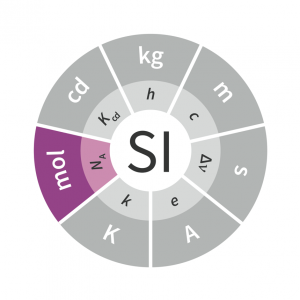After an extensive consultation with the chemistry community, and following a review and critical evaluation of the literature, IUPAC is recommending a new definition of the mole based on a specified number of elementary entities:
The mole, symbol mol, is the SI unit of amount of substance. One mole contains exactly 6.022 140 76 × 1023 elementary entities. This number is the fixed numerical value of the Avogadro constant, NA, when expressed in mol−1, and is called the Avogadro number.
The new definition is published in the January 2018 issue of IUPAC journal Pure and Applied Chemistry and is readily available online [1]. This IUPAC recommendation includes a discussion and explanatory notes. An earlier Technical Report published in July 2017 included more details and the critical review of the proposed definition of the fundamental chemical quantity ‘amount of substance’ and its unit the ‘mole’ [2].
 This new definition is in contrast to the current definition adopted in 1971 which relies on the mass of the kilogram. The new definition comes in advance of the anticipated revision of the International System of Units (SI) announced in 2011 by the General Conference on Weights and Measures (CGPM) of the Bureau International des Poids et Mesures (BIPM), the international body responsible for the global comparability of measurements. The new SI will be linking all seven base units to fundamental physical constants. In November 2018, revised definitions of the kilogram, ampere, kelvin and mole are expected to be approved by the CGPM and the revised definitions are expected to come into force on World Metrology Day, 20 May 2019.
This new definition is in contrast to the current definition adopted in 1971 which relies on the mass of the kilogram. The new definition comes in advance of the anticipated revision of the International System of Units (SI) announced in 2011 by the General Conference on Weights and Measures (CGPM) of the Bureau International des Poids et Mesures (BIPM), the international body responsible for the global comparability of measurements. The new SI will be linking all seven base units to fundamental physical constants. In November 2018, revised definitions of the kilogram, ampere, kelvin and mole are expected to be approved by the CGPM and the revised definitions are expected to come into force on World Metrology Day, 20 May 2019.
“The new definition emphasizes that the quantity ‘amount of substance’ is concerned with counting entities rather than measuring the mass of a sample, and this, commented Professor Ian Mills, is in agreement with the recommendations of both the IUPAC task group chaired by Professor Jürgen Stohner established to consider the definition of the mole, as well as the CCU (Consultative Committee for Units) of the BIPM. Professor Mills, former President of the CCU and former Chair of IUPAC Interdivisional Committee on Nomenclature and Symbols (IDCNS, committee preceding ICTNS), conceded that “It demonstrates the importance of agreement between international bodies like the BIPM and IUPAC in establishing the international conventions over the language of science. I strongly support all the proposed changes.”
Responding to the announcement of the new definition, Professor Peter W. Atkins, founding Chair of IUPAC Committee on Chemistry Education, commented as followed: “I have always been puzzled by the widespread view that the mole is a difficult subject: it has always seemed to me that many instructors tell their students that it is a sophisticated concept, and the students then wonder what all the fuss is about, suspecting that they have misunderstood it or have not appreciated its subtlety. The new definition cuts to the core of the meaning of 1 mole, and is therefore to be welcomed. Although there are subtleties in its determination, there can no longer be any excuse for misunderstanding its definition.”
The IUPAC project launched in 2013 to critically review the impact of the redefinition of the kilogram on the fundamental chemical quantity amount of substance, with its SI base unit the mole, is an excellent example of interdisciplinary work among various IUPAC Divisions, and involving the Physical and Biophysical Chemistry Division, the Inorganic Chemistry Division, the Analytical Chemistry Division, and the Committee on Chemistry Education. “The new definition of the mole emanated from this project and is backed by a broad consultation among the National Adhering Organizations represented in IUPAC as well as by a public reviewing period of about five months. Therefore, we can safely state that the chemical community supports this definition” commented Professor Jürgen Stohner, Zurich University of Applied Sciences (ZHAW), Chair of the Task Group and since 2018, Chair of ICTNS.
He continues in stating that “It is also a good example of the fruitful and constructive work of the member organizations represented within CCU on equal footing that led to this historic decision to adopt the redefinition of the mole put forward by Consultative Committee for Amount of Substance (CCQM) of the BIPM. Slight adjustments of the text were discussed during the 23rd meeting of the CCU at the BIPM in September 2017 and, consequently, it is likely that this definition will be accepted by CGPM at its next meeting in November 2018 when the final decision will be made towards implementation of the new SI.”
—
[1] Roberto Marquardt, Juris Meija, Zoltán Mester, Marcy Towns, Ron Weir, Richard Davis and Jürgen Stohner, “Definition of the mole (IUPAC Recommendation 2017)”, Pure Appl. Chem. 90(1), pp. 175-180 (2018), https://doi.org/10.1515/pac-2017-0106
[2] Roberto Marquardt, Juris Meija, Zoltán Mester, Marcy Towns, Ron Weir, Richard Davis and Jürgen Stohner, “A critical review of the proposed definitions of fundamental chemical quantities and their impact on chemical communities (IUPAC Technical Report)”, Pure Appl. Chem. 89(7), pp. 951-981 (2017), https://doi.org/10.1515/pac-2016-0808
Link to IUPAC project 2013-048-1-00: https://iupac.org/project/2013-048-1-100
For questions, please contact Jürgen Stohner
